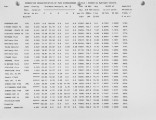| Title |
Combustion Characterisitcs of Occidental Coal-Oil Mixtures |
| Creator |
Knell, E. W.; Mansour, M. N. |
| Publisher |
University of Utah |
| Date |
1982 |
| Spatial Coverage |
presented at Newport Beach, California |
| Abstract |
Occidental Petroleum Corporation is developing coal-oil mixture (COM) as a means for partial conversion of oil burning equipment to coal. Combustion tests were performed by KVB to determine the effect of COM compositional variables and firing parameters on combustion performance. COM compositional variables examined included coal type, coal/oil ratio, coal grind size, and COM water and stabilizing additive content. Operational parameters included furnace heat release rate, furnace excess oxygen, and atomization quality. Flame stability, combustion efficiency, particulates, S0X, N0X and amenability to reduction via staging were evaluated. These data were used to establish a COM commercial formula. |
| Type |
Text |
| Format |
application/pdf |
| Language |
eng |
| Rights |
This material may be protected by copyright. Permission required for use in any form. For further information please contact the American Flame Research Committee. |
| Conversion Specifications |
Original scanned with Canon EOS-1Ds Mark II, 16.7 megapixel digital camera and saved as 400 ppi uncompressed TIFF, 16 bit depth. |
| Scanning Technician |
Cliodhna Davis |
| ARK |
ark:/87278/s63t9kr1 |
| Setname |
uu_afrc |
| ID |
3584 |
| Reference URL |
https://collections.lib.utah.edu/ark:/87278/s63t9kr1 |









































